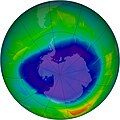File:2009 Antarctic Ozone Hole (3927062424).jpg
Appearance

Size of this preview: 600 × 600 pixels. Other resolutions: 240 × 240 pixels | 480 × 480 pixels | 716 × 716 pixels.
Original file (716 × 716 pixels, file size: 283 KB, MIME type: image/jpeg)
File history
Click on a date/time to view the file as it appeared at that time.
| Date/Time | Thumbnail | Dimensions | User | Comment | |
|---|---|---|---|---|---|
| current | 01:28, 12 May 2018 |  | 716 × 716 (283 KB) | OceanAtoll | Transferred from Flickr via #flickr2commons |
File usage
No pages on the English Wikipedia use this file (pages on other projects are not listed).
Global file usage
The following other wikis use this file:
- Usage on de.wikibooks.org
- Usage on en.wikibooks.org
